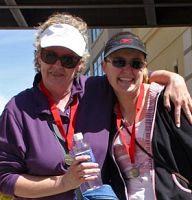Parishioners honor loved ones in the MS Walk

SALT LAKE CITY — "Any time a loved one is struggling with something you cannot fix, it is hard," said Teranie Pelch. "My mother was diagnosed with Multiple Sclerosis (MS) six years ago when she was in her mid 40s. That is really late. People are usually diagnosed in their 20s or younger." "Every 60 minutes, someone is diagnosed with MS," said Brittany Clark, communications associate of the National Multiple Sclerosis Society Utah State Chapter. "That is why we walk." Friends, family, co-workers, and Knights of Columbus teamed up for the three-mile MS Walk to raise funds to help fight MS April 14, at The Gateway in Salt Lake City. The MS Society raised $213,974.46. Several Knights of Columbus from various parishes in the Diocese of Salt Lake City participated in the Utah MS Walk in honor of Knight of Columbus Scott Posselli from St. Olaf Parish, Bountiful, and Knight of Columbus Jeff Symosky’s wife, Annette, from St. Martin de Porres Parish, Taylorsville. Posselli was diagnosed with MS in 1992, and Annette was diagnosed in 2001. Posselli and Annette were featured in an MS story in the April 28, 2006, issue of the Intermountain Catholic. "Our goal was to raise $700, and our team raised more than $800 in the MS Walk," said Andy Airriess, Knights of Columbus Utah State Community director. Sue Burn and Pelch participated in the MS Walk in Salt Lake City in honor of Pelch’s mother, Koelle Martin, who was diagnosed with MS in 2001. They are members of St. John the Baptist Parish, Draper. Martin is limited in her physical abilities, and gets discouraged because she would like to be able play more with her grandsons who are 2 and 4 years old. Martin is brought to tears when asked about her grandsons and the type of grandmother she always wanted to be. "I always planned on being one of those grandmothers who ran and jumped and played with her grandchildren, and I am not able to do that," said Martin. "But they have learned they have to come to me because I can’t lift them. If I want to give them a hug, I have to get down on my hands and knees. They know I can’t play ball or run, and that there are a lot of things that grandma just can’t do. I am sure they are more accepting of my condition than am I. "I was diagnosed with MS after my whole right side went numb, as if I had had a stroke," said Martin. "I could not feel anything on my right side at all, and I could not move anything. I could not feed myself, comb my own hair, or do anything. It was hard because I am so totally right-handed." It took Martin about a week before she could see a doctor. When she finally did, the doctor started her on a steroid treatment, which brought most of her movement back although her right side is still weak. "Now when I have an exacerbation or a relapse, they know what it is and they give me steroids intravenously," said Martin. "The steroids help relieve the swelling in my brain and hopefully bring most of my ability to move back, but it is not a guarantee." Martin’s husband, Bruce, asked for a transfer so they could move to St. George. Martin said at the lower altitude and with the warmer weather, her joints do not hurt as much and she is in a lot less pain. The move has not helped with her energy level. She is fatigued most of the time. After having MS for about two years, Martin had to quit working after an exacerbation left her without any strength in her hands. She had been working in the Intermountain Healthcare accounting department for Cottonwood, Alta View, and LDS Hospitals. Following the exacerbation, she could not work on the computer for more than 10 minutes at a time and she could not sit for very long. "Having to give up work has led to boredom," said Martin. "I worked for so many years, and now I don’t really have a reason to get up and get dressed. My debilitation has affected my whole family. I clean my own house, but I am unable to vacuum because of my shoulders. I am unstable when I walk so I have to hold on to my husband. I do not do anything without him, and he helps me with things like grocery shopping." Martin wants to make it clear this is her case scenario with MS because everyone is effected differently. Her prognosis is that her health will continue to decline, and she prays she does not end up in a wheelchair. She said each individual’s prognosis depends on where the MS is located in his or her brain. Martin’s MS is located where her spinal column connects to her brain stem. "My doctor says he does not think I will end up in a wheelchair, but I just have to see what damage my next exacerbation will do," said Martin. "The scary part is the unknown, and the fact that doctors cannot cure this disease, they can only treat it. If I knew this was as far as my debilitation was going to go, I could live with that and keep going. As it is, I live from day-to-day. All I can do is have a good outlook, keep going forward, and do the best I can do." Research has made some advances recently, but doctors can still only offer disease management drugs and therapies to the 400,000 people living with MS in America.
© Copyright 2024 The Diocese of Salt Lake City. All rights reserved.


Stay Connected With Us